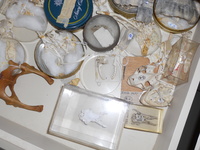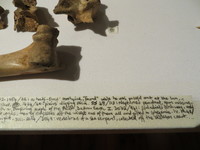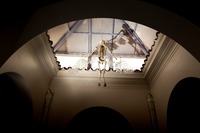Items
Site
The Medicine Chest
keywords is exactly
bones
-

Things zoological insiders look at
A sample box of archaeological specimens shown to first year students. -

Appendix (installation shot)
A variety of bones sourced from the University of Cape Town Archaeology and Zoology departments, playfully re-imagined by the students as a collection owned by a time-travelling anthropologist - collecting samples across time and sometimes, across dimensions. -

About Ed Ricketts
"Just about dusk one day in April 1948 Ed Ricketts stopped work in the laboratory in Cannery Row. He covered his instruments and put away his papers and filing cards. He rolled down the sleeves of his wool shirt and put on the brown coat which was slightly small for him and frayed at the elbows. He wanted a steak for dinner and he knew just the market in New Monterey where he could get a fine one, well hung and tender. He went out into the street that is officially named Ocean View Avenue and is known as Cannery Row. His old car stood at the gutter, a beat-up sedan. The car was tricky and hard to start. He needed a new one but could not afford it at the expense of other things. Ed tinkered away at the primer until the ancient rusty motor coughed and broke into a bronchial chatter which indicated that it was running. Ed meshed the jagged gears and moved away up the street. He turned up the hill where the road crosses the Southern Pacific Railways track. It was almost dark, or rather that kind of mixed light and dark which makes it very difficult to see. Just before the crossing the road takes a sharp climb. Ed shifted to second gear, the noisiest gear, to get up the hill. The sound of his motor and gears blotted out every other sound. A corrugated iron warehouse was on his left, obscuring any sight of the right of way. The Del Monte Express, the evening train from San Francisco, slipped around from behind the warehouse and crashed into the old car. The cow-catcher buckled in the side of the automobile and pushed and ground and mangled it a hundred yards up the track before the train stopped" (Steinbeck 1951: 279). After Ricketts' death in 1948, Steinbeck dropped the species catalogue from the earlier 'The Sea of Cortez' and republished it with a eulogy to his friend added as an afterword. -

Icarus
Perspex wings with histology slides. Histology slides are prepared by taking a sample of biological tissue and fixing it to preserve the tissue in as natural a state as possible and prevent postmortem decay. The tissue is immersed in a chemical fixative and then embedded in wax to make it hard enough to cut into very thin sections of tissue (usually 5 to 7 micrometers in thickness). It is then passed through baths of solvents which remove the wax, then through graded alcohols, water and finally through baths of haematoxylin and eosin to stain it for better viewing under a microscope.


